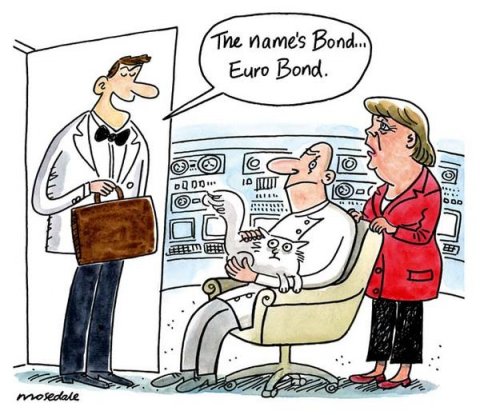Link to the Eurobond cartoon here
Monetary assets, or what we call in financial jargon securities that can be easily converted to cash, are part of the monetary policy that a central bank and/or government chooses to adopt. In brief, the monetary policy is a set of tools employed to stimulate economic growth, curb the inflation that might be lurking around and hence impact the investments directly, through levels of set interest rates, and indirectly, via direction towards which the inflation is being conducted. More on Monetary assets summarized here. In today's feature, we will be looking at eurobonds, that make one asset type, possibly issued by private organizations or governments.
The prefix "euro-" in eurobond means it is external. It has nothing to do with Europe nor the Euro as a currency. When the E is capitalized, it is when the Eurobond is actually European. Why was "euro" adopted as a prefix? Well, because the first time such an instrument was sold, it was in Europe. A eurobond is generally an international bond, i.e. an investment undergone by private individuals, commercial banks and/or governmental institutions. Because a bond is... simply a type of debt, a loan, denominated in a different currency from the native country's where it is issued. For example, an Australian company who wishes to expand to Japan can issue eurobonds in US dollars, which helps raise the money from investors interested in the flexibility of this tool and in reducing forex risk. Keep in mind that these Australian circulated bonds can be sold in any country, except the United States of America. Governments use eurobonds for long term financing.
Eurobonds are usually issued in bearer form, i.e. there is no record of their ownership: whoever holds the bond can liquidate it at maturity. They are traded on stock markets globally. Currently, securities are being traded in electronic form, and so are eurobonds, who transit through the clearing systems to the holder of the eurobond, electronically. Commonly emitted for 10 years or more, they are issued at fixed nominal face value and bear a fixed rate of interest. The latter is convenient for companies who do not have to disclose interest payments to tax authorities. Additionally, eurobonds are subject to reduced regulatory requirements, which renders them more attractive to lenders. Eurobonds in Europe explained in an animation video here
In the end, a eurobond may be a lower borrowing that remains highly liquid, but investors need to keep in mind that they are still exposed to foreign exchange risk, which is not completely forfeited, all while they can benefit from exchange rates fluctuations. What happened in Lebanon in 2020, was that the government was not able to pay its debt at maturity, for several reasons that could be explained in a different article. This in turn put the banking sector at stake, since it has always been the backbone of the expenditures of the succeeding corrupt political class. The whole ensuing financial and political crisis urged the probing for restructuring the governmental debt with tax adjustments and a saner financial strategy. Meanwhile, the country's rating has slid down to C, which is makes it extremely difficult to attract foreign investment, unless draconic measures are met to correct the very high credit risk that stains its current financial status.

